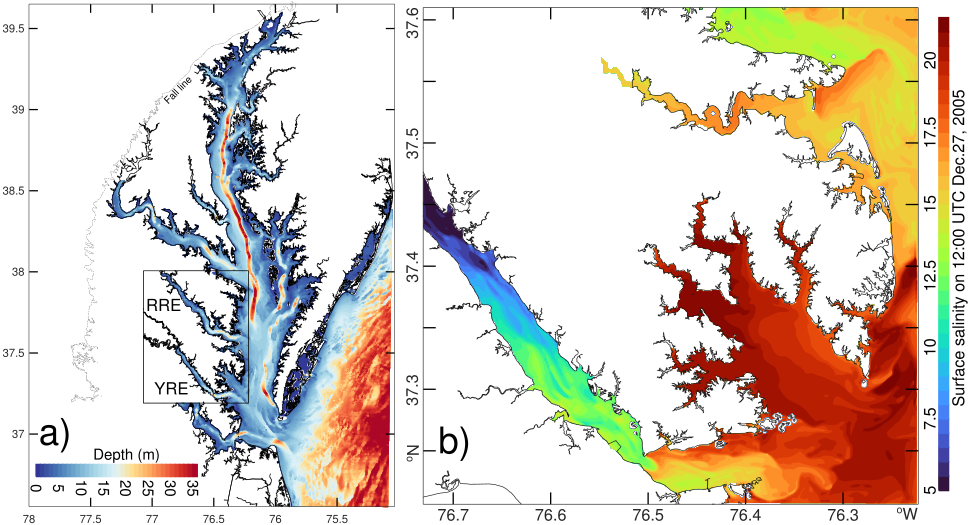
This section is an umbrella for projects (current & past) related to the Chesapeake Bay.
The videos below feature a 600m-resolution implementation of ROMS (see “Dataset”, below) that I created with support from MARACOOS and other funding agencies. This Bay-wide 600m implementation provides, in turn, lateral boundary conditions to a finer (120m) subdomain representing the southwestern Chesapeake Bay (see Figures 10–11, below).
The Bay-wide model is the basis of the Atlas of physical and biogeochemical conditions in the Chesapeake Bay.
Dataset: Numerical experiments on the sensitivity of Chesapeake Bay hypoxia to physical forcings and the associated code and input files
St-Laurent, P., M.A.M. Friedrichs, dataset (size 32 gigabytes), William & Mary ScholarWorks, 2023,
https://doi.org/10.25773/q2kh-rd09
Figure 1: Simulated surface salinity in the southern half of the Chesapeake Bay in early 2017. Note the fronts and filaments forming occasionally along the western side of the Delmarva Peninsula. A horizontal scale (2 kilometers) is provided on the left for context. The back-and-forth motion is due to the main tidal constituent (period of 12.42 hours).
For best results, download the video (.mp4) onto your device and play it from there.
Figure 2: Simulated salinity of the Chesapeake Bay in August 2005.
For best results, download the video (.webm or .ogv or .mp4) onto your device and play it from there.
The full year 2005 is also available (file salinity_chesbay_2005.mp4).
Figure 3: Simulated water temperature at the bottom of the Chesapeake Bay in August 2005.
For best results, download the video (.webm or .ogv or .mp4) onto your device and play it from there.
The full year 2005 is also available (file temperature_chesbay_bottom_2005.mp4).
Figure 4: Simulated particulate organic matter concentrations at the surface of the Chesapeake Bay in July 2005.
For best results, download the video (.webm or .ogv or .mp4) onto your device and play it from there.
The full year 2005 is also available (file pom_chesbay_2005.mp4).
Figure 5: Simulated dissolved oxygen concentrations at the bottom of the Chesapeake Bay in November 2005.
For best results, download the video (.webm or .ogv or .mp4) onto your device and play it from there.
The full year 2005 is also available (file oxygen_chesbay_bottom_2005.mp4).
Figure 6: Simulated inorganic suspended solids at the surface of the Chesapeake Bay in July 2005.
For best results, download the video (.webm or .ogv or .mp4) onto your device and play it from there.
The full year 2005 is also available (file iss_chesbay_2005.mp4).
Figure 7: Simulated salinity at the surface of the Chesapeake Bay in June 2003.
For best results, download the video (.webm or .ogv or .mp4) onto your device and play it from there.
Figure 8: Simulated salinity at the bottom of the Chesapeake Bay in June 2003.
For best results, download the video (.webm or .ogv or .mp4) onto your device and play it from there.
Figure 9: Simulated temperature at the bottom of the Chesapeake Bay in June 2003.
For best results, download the video (.webm or .ogv or .mp4) onto your device and play it from there.

Figure 10: Subdomain representing the southwestern Chesapeake Bay. I created this subdomain from scratch with support from the York River Water Quality Initiative at VIMS. (a) Bathymetry of the 600m Bay-wide grid, and geographical extent of the 120m-resolution subdomain focusing on the York River Estuary (YRE) and Rappahannock River Estuary (RRE). The bathymetry of the 120m subdomain is from Pope et al. 2016. (b) Instantaneous snapshot of the sea surface salinity simulated by the 120m-resolution subdomain. Note that the figure in (b) shows only a portion of the 120m subdomain (compare (a) and (b)).
Figure 11: Bottom dissolved dioxygen in southwestern Chesapeake Bay.
For best results, download the video (.mp4) onto your device and play it from there.